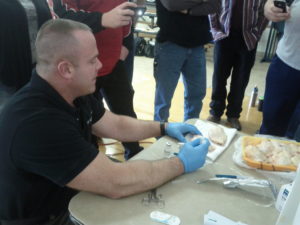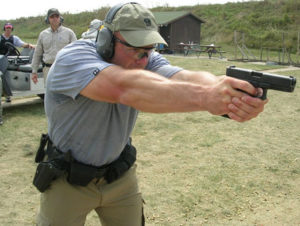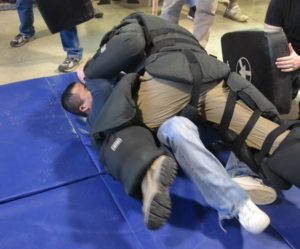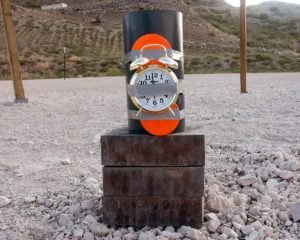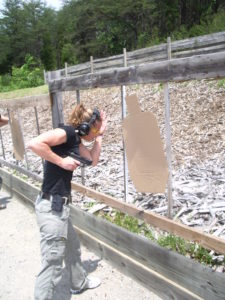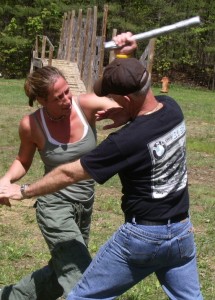MORE COMING SOON!
If you are interested in attending or scheduling any of these classes, please send us a message on our contact page.
Tactical First Aid and “System Collapse” Medicine
This hands-on class will develop proficiency in basic battlefield medical techniques utilizing the military's latest "Tactical Combat Casualty Care" protocols.
Students will learn to stop traumatic bleeding from gunshot and knife wounds using the latest pressure bandages, tourniquets, and hemostatic agents. Self care and care under fire will also be addressed.
Students will also learn simple patient assessment techniques, how to treat a sucking chest wound and tension pneumothorax as well as field fracture immobilization and expedient c-spine immobilization. Options for assuring clear airways (including improvised surgical airways) will be practiced.
In addition, students will learn how to treat themselves and families in the event of a long-term breakdown in our current medical system. Wound cleaning and disinfection under field conditions, injection of local anesthesia and wound closure (including minor suturing) will be practiced in our "trauma lab". If time permits, students will integrate all of these skills in several practical scenarios.
Information about what types of drugs to stockpile for natural disasters or a collapse in the health care system will be discussed, along with methods for legally acquiring those pharmaceuticals. The instructor will also discuss what items should be included in a comprehensive medical kit and how to improvise those items in an austere environment.
Class Length: 1-2 Days
Tactical Handgun Level 1
This is the next logical step for those who have taken a basic concealed carry class (or the equivalent) and are looking to refine your skills and practice in a more realistic context. The course will cover:
- Advanced trigger control concepts
- Drawing the weapon from concealment
- Tactical Marksmanship
- Malfunction clearances
- Shooting while moving
- Proper use of cover
Equipment requirements:
- Reliable firearm and 2 extra magazines/speedloaders
- Quality belt holster that is sturdy enough to allow one-handed reholstering
- Eye and ear protection
- 300 rounds of ammunition
Prerequisites- Basic handgun training class (CCW, NRA, or the equivalent). You must know how to operate your gun!
Class length: 1 day
Groundfighting
Combat experience shows that the majority of both civilian and law enforcement defensive encounters end up with one or both parties fighting from the ground. Acknowledging this fact, Active Response Training offers an innovative ground defense class. This ground combative system will allow you to learn the skills necessary to defend yourself in the worst case scenario when a violent criminal forces you to the ground. This is not a sport Jiu Jitsu or wrestling class. Students will learn simple, effective combat techniques that will allow them to overwhelm their adversaries and facilitate a rapid escape.
Topics covered include: ground defense positions, kicking and striking from the ground, empty hand lethal force techniques, escaping from the mount and guard positions, and choke defenses. Students will also learn how to deploy edged weapons from a grounded position and how to defend against both firearms and edged weapons on the ground.
Class Length: From 4 hours to 3 days depending on material covered.
“The Explosive Threat: Recognizing, Detecting, and Neutralizing the Terrorist Bomber”
Do some research on terrorist and active shooter events both domestically and worldwide. There is a growing trend. Terrorists and Active Shooters use bombs to increase their body count.
Did you know that majority of terrorist events that have occurred in the United States have been bombings? Did you know that many of the more famous active shooter events also involved bombs? This trend is only likely to increase as terrorists implement the expertise and tactics they have learned on the battlefields of Iraq and Afghanistan. In today’s ever-hostile environment, knowledge about explosive devices has become critical for both police officers and aware citizens.
In this 4-hour class you will learn about:
- Basic explosive characteristics
- Terrorist Bomb Designs
- Improvised Explosive Devices
- How to search a building or vehicle for bombs
- Response tactics for dealing with a suicide bomber
- A de-brief of recent terrorist bombing incidents
- Safe standoff and evacuation distances
- How active shooters add to their body count with bombs
- How to recognize precursor chemicals used to make homemade bombs
- How to avoid secondary devices
- Tactics of the Terrorist Bomber
The class will be a combination of lecture, video analysis, and group practical exercises. You will see video of numerous actual bombing incidents for debriefing. Additionally, video of individual detonations of each type of commonly-used explosive will be shown. After the lecture/video de-brief we will conduct some group practical scenario training exercises (bomb searches and dealing with suicide bombers) to further reinforce the knowledge you’ve obtained.
Class Length: 4 hours
Extreme Close Quarters Gunfighting
The skills you learned on the target shooting range or in your CCW class may not work for you when the fight happens within arms’ reach. Extreme close range gun fighting is a completely different skill set, one that relies far more on FIGHTING than on mere shooting.
With up to 50% of gunfights occurring at ranges closer than five feet, you need this skill set! Join Greg Ellifritz as he teaches a dynamic close quarters gun fighting class that will cover the following topics:
- Retention Shooting Positions
- Body positioning and shooting stances for the close quarters fight
- In-fight weapons access and drawing skills
- Stopping and opponent’s draw
- Making contact shots without creating malfunctions
- Close quarters gun disarms
- One handed close quarters malfunction drills
- Using the pistol as an impact weapon
- Drawing and shooting from unconventional positions
- Weapons access and gun fighting from the ground
- Rescuing a partner or family member who is in an opponent’s clinch
- Weapons retention, both in holster and in hand
- and numerous other techniques!
This is not the class for a beginning shooter! Proper gun handling skills and evidence of prior training is a prerequisite for the course. Prior training in a combative martial art or police defensive tactics class will be useful, but not required. The class will be somewhat physically demanding, so please show up expecting to work hard.
Length: 4 hours- 2 days depending on material covered
Snubby Revolver for Concealed Carry
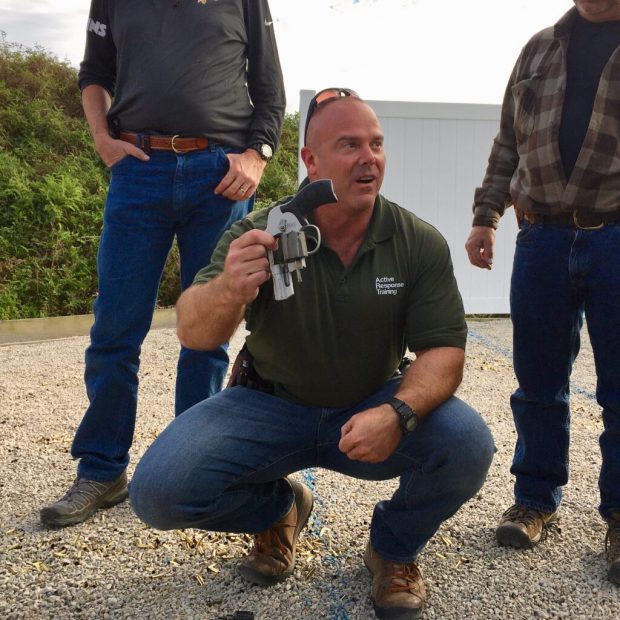
This course is designed to teach students how to most effectively employ a short-barreled revolver in a defensive situation.
The class will cover:
-Choosing optimal revolvers and support gear
- Holsters and carry issues
- Shooting quickly and accurately with a snubby revolver
- Recoil mitigation techniques
- Reloading techniques using loose cartridges, speed loaders, and speed strips
- Close quarters shooting with the revolver
- One handed firing with both strong and support hands
- Strategic application of the snubby revolver in combat
This is not a beginning shooting course! Students are expected to have completed CCW- level or greater training prior to taking this class. Students should be able to safely handle their firearm, load and unload it, and be able to safely draw from the holster before enrolling. If students do not have these necessary skills they will be removed from class.
Equipment list:
-Revolver with a barrel length of three inches or less
- Belt holster (either inside or outside the waistband) or pocket holster. No ankle holsters, shoulder holsters, or fanny packs.
- 300 rounds of practice ammunition for your revolver
- At least two speed strips. I prefer the eight-round strips made by Tuff Products, but Bianchi and other manufacturers’ options are fine.
- At least two speed loaders. Whatever brand you prefer is fine by me. We will discuss the relative advantages of each loader type in class. If you don’t already have loaders, the HKS models are probably the cheapest and are perfectly adequate.
- Grips that will allow you to use your chosen speedloader. Try it before class. Many grips are cut in such a fashion that they do not provide enough clearance for speedloader use.
- Eye and Ear protection (electronic hearing protection is preferred).
Length: 1- day
Knife Skills for Concealed Carry
The Basic Knife Skills for Concealed Carry class is an introductory course designed to give people who normally carry a concealed pistol an alternate defense option if they venture into areas where carrying their pistols is illegal or impractical.
Topics covered will include:
• Choosing a defensive knife
• Carry locations
• Drawing and opening the folding knife under stress
• Basic cutting angles and targets
• The three ways to use a knife to stop an attack
• Escaping life-threatening physical attacks with a knife
• Transitioning between knife and pistol
• Weapon retention using the knife
The class will not be knife specific. Both fixed and folding blade training knives will be provided by the instructor. All ages and fitness levels will be accommodated.
Length: 2 hours to one day
Mini-Baton and Pepper Spray Class
This one-day class teaches students the skills they need to bridge the gap between empty hand and lethal force responses. Topics covered will be:
- Selection of chemical irritants
- Formulations and delivery systems
- Acquisition and deployment of chemical sprays
- Decontamination procedures
- Striking with the mini baton
- Pressure point baton controls
- Escaping common grabs and holds using the baton
This class is suitable for anyone, regardless of age or physical conditioning. It will be a combination of lecture, practical exercises, and optional force-on-force simulations. Students will not be sprayed with chemical irritants!
This is an ideal class for citizens who are unable to carry a firearm in some locations or for law enforcement officers looking to improve their less-lethal skills. All students will be provided with their own mini batons and inert chemical irritant spray containers.
Defensive Shotgun Class
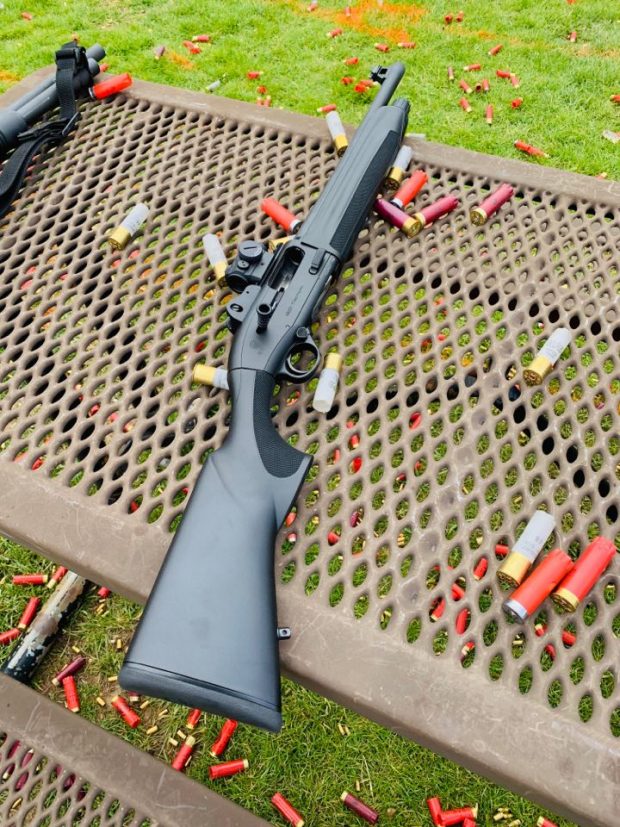
This class is designed to quickly bring students to a high level of proficiency in the art of using a shotgun for personal or home defense. The class will cover the following topics:
- Selecting the shotgun, ammunition, and accessories
- Buckshot patterning for optimal performance
- Rapid target acquisition
- Methods to reduce the recoil of the shotgun
- Proper shooting techniques
- Loading/Unloading/Reloading the shotgun, stressing emergency reloads and ammo management
- Buckshot to slug transitions
Students will need the following supplies:
- Reliable pump action or semi-automatic shotgun. We recommend the Remington 870, Remington 11/87, Mossberg 590, Benelli “M-series,” or the Beretta 1201/1301. Barrel lengths under 20 inches are preferred. Your shotgun should have a stock. Pistol-grip only shotguns and firearms like the Mossberg Shockwave are not suitable for this class.
- Shotguns break more often than handguns do. Bringing a spare shotgun, if available, is an excellent idea.
- Your shotgun should be equipped with a sling if possible.
- Hearing Protection, (electronic is preferred) and eye protection
- Some method of storing extra ammunition on your shotgun or on your person (side saddle, dump bag, pockets, etc.)
- Clothing suitable for spending the entire day outside
- Lunch, water, and snacks.
- 125 rounds of birdshot (whatever is cheapest yet still cycles your gun)
- 15 rounds of your preferred defensive buckshot. Any generic 00 Buck load will work for the class, but I recommend the Federal Flight Control buckshot (#1 or 00) or the Hornady 8-pellet TAP 00 buck shells. Low recoil buckshot loads are not recommended for semi-automatic shotguns. I do not recommend three inch shells or any “magnum” loadings.
- 10 shotgun slugs

